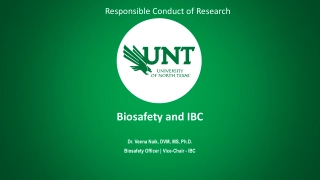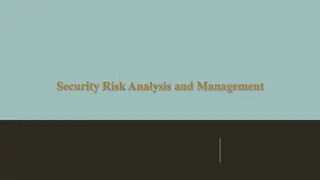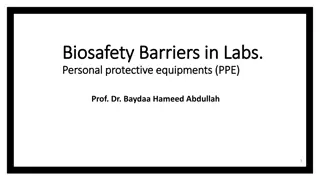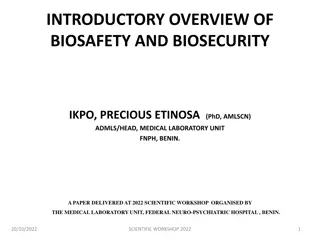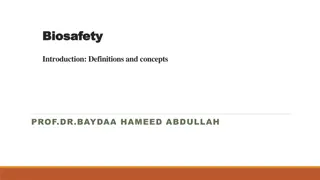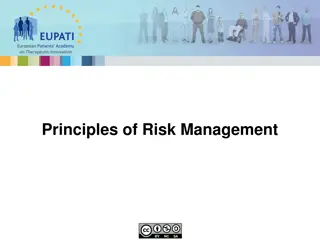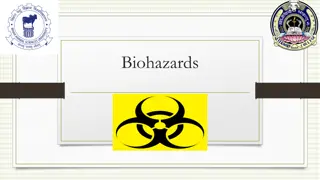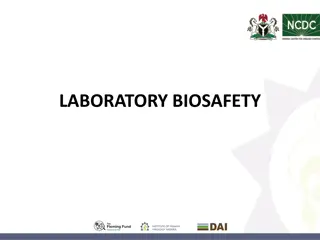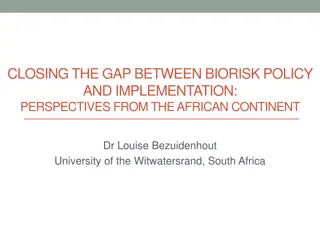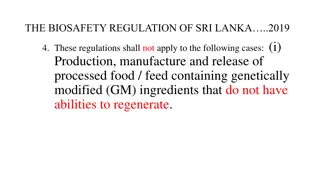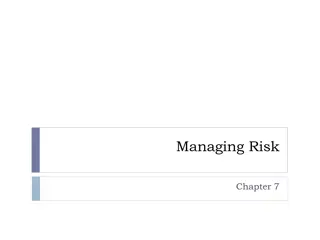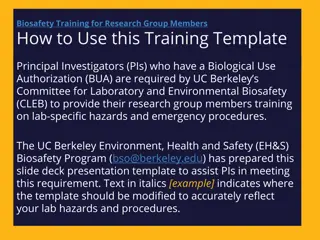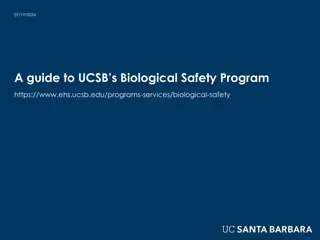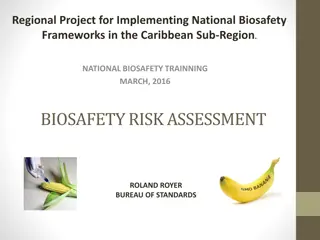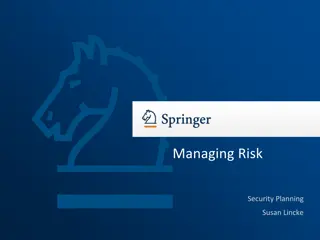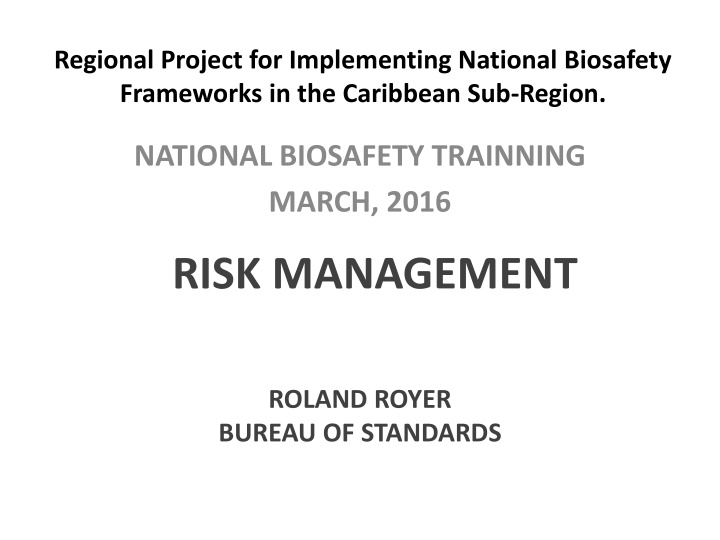
Implementing National Biosafety Frameworks in the Caribbean Sub-Region
This document discusses risk management and assessment in the context of implementing national biosafety frameworks in the Caribbean Sub-Region. It covers key concepts such as hazard, exposure, and how risk is determined based on these factors. The importance of clear objectives, testable hypotheses, and scientific methods in risk assessment is emphasized. Examples are provided to illustrate how risk can vary based on different levels of exposure to hazards. Overall, the content highlights the essential components of risk analysis and the role of risk communication.
Download Presentation

Please find below an Image/Link to download the presentation.
The content on the website is provided AS IS for your information and personal use only. It may not be sold, licensed, or shared on other websites without obtaining consent from the author. If you encounter any issues during the download, it is possible that the publisher has removed the file from their server.
You are allowed to download the files provided on this website for personal or commercial use, subject to the condition that they are used lawfully. All files are the property of their respective owners.
The content on the website is provided AS IS for your information and personal use only. It may not be sold, licensed, or shared on other websites without obtaining consent from the author.
E N D
Presentation Transcript
Regional Project for Implementing National Biosafety Frameworks in the Caribbean Sub-Region. NATIONAL BIOSAFETY TRAINNING MARCH, 2016 RISK MANAGEMENT ROLAND ROYER BUREAU OF STANDARDS
RISK MANAGEMENT Risk management is one of the components of Risk analysis. It is linked to the conclusions of the Risk Assessment RISK ANALYSIS RISK ASSESSMENT RISK MANAGEMENT RISK COMMUNICATION
RECAP ON RISK ASSESSMENT The risk assessment is NOT a tool to prove safety It is a tool to gather information and analyse it so.... decisions can be made The risk assessment uses scientific methods, but is not a research project Clear objectives of protection are established Specific testable hypothesis are formulated Sound scientific methods are applied to generate RELEVANT data Conclusions are supported with relevant information Identifies uncertainties Uncertainty is intrinsic to risk assessment All activities carry some risk. There is no such thing as zero risk. When the uncertainty is too high or the potential consequences of serious concern, risk management tools can be used
RECAP ON RISK ASSESSMENT Remember! Risk = f (Hazard, Exposure) EXPOSURE likelihood, frequency, timing and level of contact with an agent or stressor HAZARD potential of an agent to cause harm Risk Hazard If there is no hazard, the risk will be negligible If there is no exposure, the risk will be minimal The risk assessment requires an estimation of hazard and exposure
RECAP ON RISK ASSESSMENT PARACETAMOL Common over the counter pain killer Hazard to humans: the maximum daily dose recommended is 3g/day(6 tablets of 500mg per day) EXPOSURE None LOW RISK LOW RISK HAZARD 3g/day EXPOSURE 6 tablets The same hazard, different risks depending on exposure EXPOSURE None HIGH RISK
RISK ASSESSMENT EXAMPLE: Hazard Exposure Laboratory research (contained use Field research (confined use) Import for use as food and/or feed Commercial cultivation Same hazard, different exposure. Risk may differ.
RISK MANAGEMENT When do we need to consider management measures? When the risk assessment identifies a potential risk that can not be ruled out with available information To address specific uncertainties identified during the risk assessment To take measures to reduce either hazard or exposure in environmental releases.
RISK MANAGEMENT Requires a risk management plan that Has clear objectives Describes the risk measures that will be implemented Indicates how the effectiveness of the measures will be monitored Indicates how and how o]en reviews will take place
RISK MANAGEMENT The management measures must be proportional to the level of risk The idea is to focus risk management on measures to mitigate moderate and high risks so they can be acceptable Considers the scale: CFT/Commercial release
RISK MANAGEMENT Consider: What risks are you trying to mitigate? Which risk hypothesis are you examining? What data will you consider relevant? What is the conclusion?
RISK MANAGEMENT CONFINED FIELD TRIALS Experimental confined releases are a key part of the development and safety evaluation of GM crops At the time of release, information on hazard or exposure may not be available Management measures are taken to minimize potential risk To minimize hazard To minimize exposure
Avoid/control flowering Physical barriers Pollen flow to wild relatives or other maize Grain or forge entering food/ feed chain Distance to other crops of the same species Destruction of all plant material at the end of the trial Different flowering time Temporal barriers Nets
RISK MANAGEMENT CONFINED FIELD TRIALS
RISK MANAGEMENT Uncertainty and Confined field trials during development: data uncertainty Commercial release trial 1 trial 2 trial 3 More data on GMO and on its environmental effects means less uncertainty for the risk assessment.
RISK MANAGEMENT COMMERCIAL RELEASES If a specific risk is identified during the risk assessment, but is considered acceptable under certain management conditions, permits may be granted, but management or monitoring measures are imposed as a condition. Examples: Mexico: GM codon is approved for commercial cultivation, but exclusion areas have been identified. USA: approved corn rootworm resistant maize, but requested that the developer conducted more NTO field trials for two years.
RISK MANAGEMENT COMMERCIAL RELEASES: LICENSE CONDITIONS Scope (what, where, how, how many) General obligations Specific conditions Monitoring Reporting Unexpected situations/data
GMO Decision-making Risk Assessment and Risk Management together should form the basis upon which the Decision-maker(s) decide whether to issue or review a licence/a de-regulation, and what conditions to impose if a licence is issued/de-regulation is permitted The Decision-maker(s) must be satisfied that risks can be managed to protect human health and safety and the environment If the Decision-maker(s) considers that risks posed by proposed activities with a GMO cannot be managed, a licence/de-regulation would be refused Decision-maker(s) communicate decision
GMO Risk Communication Is integral to the process of risk analysis Involves an interactive dialogue between the Decision-maker(s) and stakeholders to build trust in the regulatory system - by discussing issues and addressing concerns relating to the Protection Goals Differing perceptions of risk can influence the approach of stakeholders to particular issues - in such instances, the Decision-maker(s) may seek advice on ethical and social issues from a designated committee The Decision-maker(s)may provide information to interested parties on applications, risk assessment and risk management plans, activities with GMOs, trial sites, and the processes of risk assessment, risk management, and monitoring and compliance activities May publish/make available guidance documents as part of efforts towards clarity, transparency and accountability of decision-making process

